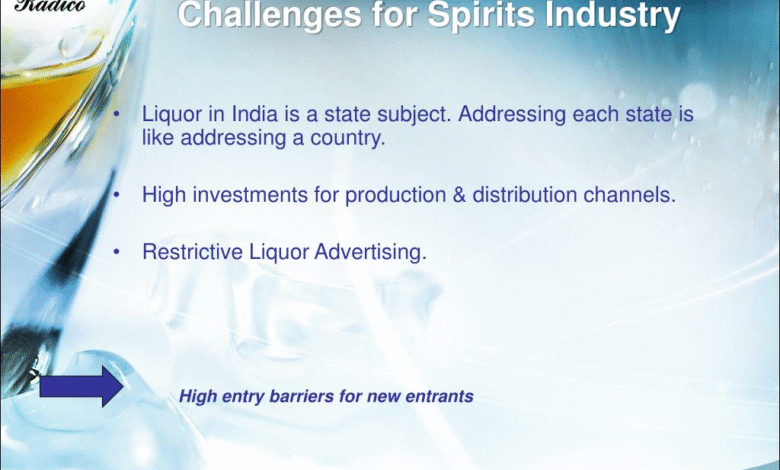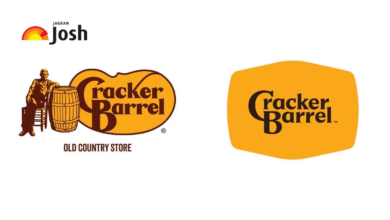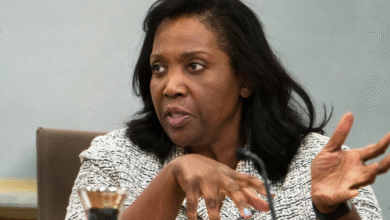Spirits Industry Challenges: Tariffs and Changing Trends

The spirits industry challenges have become increasingly prominent as global producers navigate a complex landscape defined by shifting consumer preferences, economic uncertainty, and geopolitical tensions. With the spirits market decline exacerbated by U.S.-China trade tariffs, brands are feeling the pressure more than ever. Major players like Rémy Cointreau and Diageo have reported significant drops in sales, particularly in the cognac market, where a decline in consumer drinking habits has led to a corresponding dip in demand. As premium alcohol trends fluctuate and brand loyalties are tested, the entire sector is left grappling with the ramifications of these changes. The intersection of these challenges has created a volatile environment for spirits makers, prompting a reevaluation of sustainability and growth strategies in a rapidly evolving market.
The landscape of alcoholic beverages is currently undergoing substantial transformation, marked by significant difficulties for producers of distilled spirits. Emerging issues including shifts in consumer preferences, tariff-induced trade complications, and economic fluctuations are at the forefront of this evolving narrative. As whiskey, rum, and other premium beverages face a downturn in popularity—coupled with a notable drop in cognac sales—companies are left to grapple with aligning their offerings with changing consumer habits. These trials, stemming from both cyclical economic factors and broader social movements towards moderation, are reshaping the spirit world’s future. With consumers increasingly prioritizing health and wellness, the industry must adapt or risk further declines.
The Spirits Industry Challenges Amid Economic Uncertainty
The spirits industry currently faces a myriad of challenges exacerbated by global economic instability. Tariffs, particularly the ongoing U.S.-China trade disputes, are causing essential shifts in production and pricing. Producers like Rémy Cointreau and LVMH report steep declines in cognac sales, directly linked to decreased consumer consumption in key markets like the U.S. and China. The unpredictability in market conditions makes it exceedingly difficult for brands to set long-term sales targets, leading to withdrawals from established forecasts. Analysts fear that these economic factors might align to create a sustained downturn in the spirits market.
Furthermore, these economic pressures are compounded by changing consumer drinking habits. As consumers become more health-conscious and cautious about their spending, there’s a significant shift towards lower-cost alternatives or ready-to-drink (RTD) options. This evolution in consumer preferences is challenging traditional spirits brands to adapt swiftly, as many find themselves competing against a burgeoning market of lower-priced, flavorful RTD alternatives. These market dynamics underscore the multiple layers of complexity currently encompassing the spirits industry.
Impact of U.S.-China Trade Tariffs on Spirit Sales
The imposition of U.S.-China trade tariffs has intensified competitive pressures within the spirits sector, especially for producers reliant on international markets. Brands like Rémy Martin have reported alarming drops in their sales figures, attributing a 22% decline specifically to reduced consumption in the U.S. and unfavorable trading conditions in China. This trend raises serious concerns about the long-term viability of premium spirits brands that thrive on global consumer bases. With tariffs expected to have significant financial repercussions, projected to cost Rémy Cointreau about $55 million, the impact is widening throughout the industry.
Moreover, the spirits industry’s inherent reliance on regional authenticity, as illustrated by the strict regulations tied to cognac production, further amplifies its exposure to tariffs. Traditions dictate that products like Champagne must be crafted and bottled in their specific regions, leaving them perilously susceptible to extra costs incurred from these trade barriers. As producers grapple with ongoing tariff implications, it becomes essential to rethink pricing strategies and market positioning, lest they lose ground against competitors who might navigate these challenges more efficiently.
Shifts in Consumer Drinking Habits
Recent shifts in consumer drinking habits, influenced by a growing emphasis on health and wellness, are carving a new landscape for the spirits industry. The rise of ‘sober curiosity’ has sparked a trend where consumers are exploring low and non-alcoholic alternatives more than ever before. Beverage companies are already reacting to these shifts by expanding their portfolios to include lower-alcohol and no-alcohol products. This signifies a crucial pivot for the spirits market, traditionally buoyed by premium offerings, which now must compete in an increasingly health-conscious environment.
As economic factors tighten, consumers may also reassess their spending on premium spirits priced as high as $100. Instead, many are opting for more accessible methods of social drinking that suit their lifestyles, including affordable ready-to-drink cocktail options. This change in behavior reflects broader societal trends where occasional indulgence is increasingly favored over habitual consumption, thus challenging the spirits industry to innovate and retain customer loyalty amidst these evolving preferences.
Cognac Sales Decline in the Premium Segment
The premium spirits segment, particularly cognac, has experienced notable declines, raising alarms within the industry. Major producers like Rémy Cointreau and LVMH have reported significant drops—22% and 17%, respectively—in cognac sales, which have been attributed to shifting market dynamics coupled with reduced consumer interest in higher-priced options. This decline not only impacts the companies financially but also challenges the very perception of cognac as a symbol of luxury, potentially leading to an erosion of its market presence.
Furthermore, the decline is set against a backdrop of a broader market correction where premium products face increasing competition from accessible brands and alternatives. As consumers reassess their spending habits, traditional luxury categories may find it challenging to appeal, especially when consumers are stocked with spirits acquired during the pandemic. Unveiling new marketing strategies and product innovations to rejuvenate interest in premium cognac will be vital for reviving the segment and reclaiming its status in the spirits hierarchy.
Consumer Behavior Trends in the Alcohol Market
Today’s alcohol market is witnessing transformative shifts in consumer behavior that are reshaping the industry landscape. In recent years, factors like health consciousness and the popularity of weight loss medications have prompted many individuals to moderate their alcohol consumption. As more people explore the benefits of reducing alcohol intake, the demand for spirits is facing challenges from both direct competition and overall consumer shifts toward healthier lifestyle choices.
Moreover, businesses are adapting to this reality by launching innovative lower-alcohol and no-alcohol beverages aimed at meeting changing consumer expectations. This aligns with the growing trend of mindfulness in drinking habits, encouraging brands to diversify offerings while remaining relevant in an evolving market. Understanding and adapting to these changes is not just a matter of survival; it is an opportunity for brands to connect meaningfully with a new generation of consumers.
Premium Alcohol Trends in a Competitive Landscape
Amidst growing economic uncertainties, premium alcohol trends are undergoing significant evaluations. Brands that once thrived on the demand for high-end spirits are now reconsidering their positioning as consumer behaviors shift. With many choosing to downsize their alcohol expenditures, there’s an urgent need for companies to innovate and maintain their allure in the eyes of previously loyal customers. While the premium segment remains relatively stable with whisky, tequila, and gin holding up, products traditionally seen as indicators of luxury are increasingly scrutinized against more economical options.
While premiumization defined the marketplace during the pandemic, the tides are turning as consumers become more pragmatic in their choices, affecting overall sales. Thus, spirits brands need to clarify their value propositions and continue to emphasize unique qualities that set them apart in increasingly competitive environments. Ultimately, navigating through these evolving premium trends will require a balance between consumer engagement and sustaining brand prestige.
Navigating Tariffs and Brand Boycotts in the Spirits Industry
The intertwined issues of tariffs and brand boycotts present formidable challenges for the spirits industry, demanding tactics to navigate an increasingly complex landscape. With U.S.-China trade tensions continuing to escalate, the added layer of tariffs means that companies like Diageo and Rémy Cointreau are reassessing their operations and potential growth trajectories. Brand loyalty becomes especially paramount as consumers may shift to local alternatives or boycott foreign products due to political climates, making it critical for brands to enhance their local presence.
In this scenario, the ability to adapt swiftly to geopolitical tensions is essential for long-term survival. Spirits brands must revise their marketing strategies to address consumer sentiments and political currents while ensuring that they adhere to local production standards, which often hold higher prestige. Balancing these factors is pivotal in maintaining market share amidst fluctuating economic conditions and changing buyer preferences.
Future Prospects for the Spirits Market
Looking ahead, the spirits industry faces a mixed bag of challenges and potential opportunities, hinging on how companies adapt to current conditions. Analysts suggest that while some downturn is temporary and rooted in cyclical pressures—largely attributed to the economic fallout from the pandemic—the structural changes could lead to permanent shifts in consumer behavior. This gives rise to the potential for innovation, particularly in developing low and no-alcohol alternatives, which could prove beneficial in capturing a shifting customer base.
Transitioning from these cyclical challenges towards growth may require brands to foster a deeper understanding of consumer preferences while concentrating on product quality and regional authenticity. As companies recalibrate their strategies, there exists an opportunity to reinvigorate brand loyalty among consumers who are navigating through the changing landscape of the spirits market. Indeed, the key to future success will lie in the industry’s resilience and ability to adapt creatively to ongoing transformations.
Conclusion: The Spirit of Adaptation in a Changing Industry
In conclusion, the spirits industry is grappling with a complex array of challenges that demand not only resilience but also innovative thinking. The impacts of U.S.-China trade tariffs and evolving consumer habits are reshaping the very fabric of the market, forcing brands to reevaluate how they connect with consumers. As the industry continues to respond to external pressures, the essence of success will hinge on the ability to adapt to new realities while maintaining the brand ethos that resonates with consumers.
Ultimately, navigating through the storms of economic uncertainty and consumer evolution will require a blend of strategy, agility, and informed decision-making. As some traditional notions of luxury may shift, those brands which remain attuned to consumer desires and market trends will likely emerge stronger in the long run, ensuring that the spirit of innovation thrives within this dynamic marketplace.
Frequently Asked Questions
What are the main factors contributing to the spirits market decline in 2023?
The spirits market decline in 2023 is primarily driven by macroeconomic uncertainty, U.S.-China trade tariffs, and shifts in consumer drinking habits. Economic challenges have led to a decrease in sales for premium brands, with consumers opting for lower-cost alternatives and ready-to-drink options. Additionally, ongoing geopolitical tensions further complicate the market environment.
How are U.S.-China trade tariffs affecting the spirits industry?
U.S.-China trade tariffs significantly impact the spirits industry by increasing the costs for imported products, especially premium spirits. Companies like Rémy Cointreau and Diageo have reported considerable financial losses attributed to these tariffs, which can elevate expenses by millions, thereby discouraging consumer spending on higher-priced items.
What challenges are cognac brands facing in the current market?
Cognac brands are facing substantial challenges, including a 22% decline in sales due to reduced U.S. consumption and complex market conditions in China. The economic climate and increased trade tariffs have made it difficult for producers like Rémy Cointreau and LVMH to maintain sales targets, reflecting broader trends in the spirits market.
How are changing consumer drinking habits impacting the spirits industry?
Changing consumer drinking habits, including a growing trend towards health and wellness, are negatively impacting the spirits industry. The rise of ‘sober curiosity’ and reduced alcohol consumption are influencing consumers to choose low and no-alcohol products over traditional spirits, leading to a decline in overall spirits sales.
What is the impact of premium alcohol trends on spirits production?
Premium alcohol trends initially led to growth in the spirits industry, as consumers began favoring higher-quality products during the pandemic. However, current shifts towards value-oriented purchasing and inflationary pressures are causing a slowdown in premium spirits sales, indicating a need for brands to adapt to evolving consumer preferences.
What future challenges does the spirits industry face?
The spirits industry faces multiple future challenges, including persistent economic uncertainty, the lasting effects of U.S.-China trade tariffs, and evolving consumer preferences towards lower-alcohol and no-alcohol alternatives. Analysts predict that growth in the U.S. spirits market will be lower than historical rates, as companies navigate both cyclical and structural changes.
How does inflation affect consumer choices in the spirits market?
Inflation has led consumers to be more cautious about their spending on premium spirits. As prices rise, many are opting for lower-cost or ready-to-drink alternatives, which directly impacts sales across the spirits industry. This trend highlights the importance for producers to innovate and offer competitive pricing strategies.
What role do health trends play in the spirits industry?
Health trends, particularly the rise of sober curiosity and the introduction of weight loss medications, play a significant role in reshaping the spirits industry. These trends encourage consumers to explore lower-alcohol options or abstain from alcohol altogether, prompting many brands to diversify and introduce low and no-alcohol product lines.
| Key Points |
|---|
| Global spirit producers face significant challenges due to tariffs, brand boycotts, and a shift in drinking habits. |
| Rémy Cointreau, Diageo, and Pernod Ricard have withdrawn sales targets citing economic uncertainties and geopolitical tensions, particularly related to U.S.-China tariff policies. |
| Declines in sales: Rémy Cointreau’s cognac sales dropped by 22%, while LVMH saw a 17% decline in Hennessy cognac. |
| Trade barriers and tariffs are significantly impacting spirits, making them more vulnerable compared to beer due to their local production requirements. |
| The spirits industry has shifted from a growth period during the pandemic to a decline as economic conditions change, with consumers leaning toward lower-cost alternatives. |
| Health and wellness trends are influencing consumer behavior, with more individuals exploring low and no-alcohol options, further impacting traditional spirits sales. |
| Analysts are divided on if the downturn in demand is cyclical due to excess supply post-pandemic or structural due to behavioral shifts among consumers. |
Summary
The spirits industry challenges are significant as producers grapple with tariff impacts, changing consumer preferences, and increasing health awareness. Major brands are adjusting their strategies in response to a decline in sales and adverse market conditions. Analysts predict that the industry may not return to previous growth levels, underscoring the need for innovative approaches to engage consumers and maintain market share in this evolving landscape.




